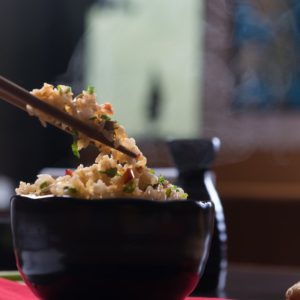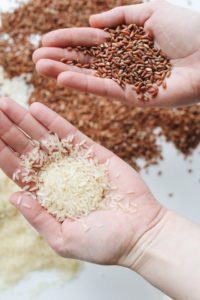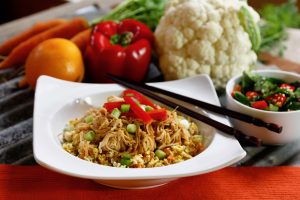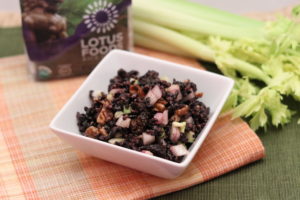 As we know all too well by now, there is mass confusion when it comes to food.
As we know all too well by now, there is mass confusion when it comes to food.
And rice is no exception.
One day you hear that brown rice is always better than white rice. The next day you see the headline, “Why White Rice is Healthier Than Brown Rice.”
So, what’s the REAL story?
And what kind of rice should you choose?
We want to help reduce the confusion and make your decision easier.
First, what is rice?
Rice is actually a seed of a grass species. It is gluten-free, comes in many varieties and has become a staple in many diets around the world. Interestingly, rice makes up for more than 20% of the calories consumed by humans worldwide. Some of the countries where rice is a staple are among the healthiest countries in the world (like Okinawa, Japan). Other countries where rice is a main part of the diet are not so healthy (the Marshall Islands, for example, which has a high rate of type-2 diabetes).
 There are many, many varieties of rice:
There are many, many varieties of rice:
- Short-grain (sticks together when cooked)
- Medium-grain (longer than short-grain and sticks together when cooked, but not as much as short-grain)
- Long-grain (most commonly used in cooking because it is fluffier and is less likely to stick together).
Brown and white rice are the most common varieties found in U.S. supermarkets, but you can also find other varieties:
- Arborio (a short-grain rice used to make risotto)
- Basmati (a long-grain rice, often grown in India and Pakistan)
- Black rice (also known as forbidden rice, it is a medium-grain and loaded with antioxidants)
- Red rice (nutrient-rich)
- Wild rice (which is actually a grass and has a unique – and wonderful – texture)
The rice debate: brown or white?!
 Picture this…you’re at the store staring at the many varieties of rice to pick from and your head is starting to spin. What if the brown rice and white rice could talk to you to make their case as to why you should choose them?
Picture this…you’re at the store staring at the many varieties of rice to pick from and your head is starting to spin. What if the brown rice and white rice could talk to you to make their case as to why you should choose them?
The brown rice might confidently say something like, “If you are trying to eat healthy, I am the obvious choice. Sure, my non-edible hull has been removed, but my bran and germ remain intact, which means I will provide you with fiber, antioxidants, vitamins and minerals. My competitor over there won’t give you that…just sayin’.”
 The white rice anxiously jumps in and says, “Sure, they may have stripped away my bran and germ, but some nutrients have been added back, and if you’re eating rice in moderation, the differences aren’t that significant. And, you’re part of the Eat REAL America community, so you’re getting plenty of nutrients from your vegetable-loaded meals. Plus, my friendly competitor over there isn’t telling you the whole story…why don’t you ask him about the big A’s (antinutrients and arsenic)?
The white rice anxiously jumps in and says, “Sure, they may have stripped away my bran and germ, but some nutrients have been added back, and if you’re eating rice in moderation, the differences aren’t that significant. And, you’re part of the Eat REAL America community, so you’re getting plenty of nutrients from your vegetable-loaded meals. Plus, my friendly competitor over there isn’t telling you the whole story…why don’t you ask him about the big A’s (antinutrients and arsenic)?
The brown rice passionately leaps in with: “Boy, that was a cheap shot. Yes, I may contain a little phytate, but so do nutritious foods like nuts, beans, and spinach. Some call this an “antinutrient” because it affects your ability to absorb beneficial nutrients. But if you are eating us in moderation, that shouldn’t be a significant concern. The same is true for arsenic. Sure, I may have a little more arsenic than my friend over there, but that is because my whole grain remains intact and, unless you are eating rice every day for years, this shouldn’t be a big deal. Speaking of not telling the whole story, why don’t you talk about the big D (type-2 diabetes)?”
The white rice, doing the classic forehead slap, says “Talk about a low blow! I guess if you are at high risk for diabetes, your extra fjber and minerals are something to consider. However, I am unlikely to be the reason someone gets type-2 diabetes…their intake of highly processed foods with added sugars (and lack of vegetable-rich meals) is what is going to determine their risk for type-2 diabetes. Remember, this is an Eat REAL America member you are talking to…if he or she eats a little white rice once in a while, that is not going to significantly increase his or her diabetes risk.”
The brown rice eventually responds, “OK, good point.”
If you still look confused, either the brown or white rice may save your sanity and say, “Look, the reality is either of us can be part of a healthy diet. It is your overall diet that matters most and, if you are pairing us up with a huge portion of veggies, a little seafood or grass-fed meat, and a flavor-filled sauce, you will have one nutritious and delicious meal, no matter which one of us you choose.”
Hopefully, this enlightening conversation in the rice aisle clears up some of the confusion!
Here is our take on it:
- Enjoy rice occasionally, and in moderate portions, as part of a healthy lifestyle.
- We try to mix it up and enjoy red, black and wild rice. When it comes to brown vs. white, we generally opt for brown rice, but don’t obsess about it and occasionally enjoy white rice, especially when eating sushi or risotto.
 In the past, the U.S. Food and Drug Administration has issued guidance discouraging pregnant women and parents from using rice or rice cereals as the PRIMARY grain staple due to arsenic contamination.
In the past, the U.S. Food and Drug Administration has issued guidance discouraging pregnant women and parents from using rice or rice cereals as the PRIMARY grain staple due to arsenic contamination.- To reduce arsenic levels, you can look for brown basmati rice from California, India or Pakistan, which has lower levels. We pulled out three bags of rice from our pantry while writing this coaching tip and all three were from these regions, so they are readily available. You can also wash your rice before cooking it, and use more water when cooking, to reduce arsenic levels further.
- Add variety…black, red and wild rice are great options. And try to enjoy a variety of other whole grains, such as barley, bulgur, farro, freekeh and quinoa, just to name a few.
- Even more plant-based options! Don’t forget about cauliflower rice! And you can also buy hearts of palm rice (it doesn’t have a lot of flavor on its own and doesn’t have the slight crunch of regular rice, but it can be a good substitute in dishes where it absorbs a tasty sauce). Although we haven’t tried them yet, a couple other options include chickpea and red lentil “Risoni” (sold by Trader Joe’s) and RightRice (which provides a nice boost of plant-based protein and fiber).
Try some of these absolutely delicious recipes:
Slow Cooker Asian Chicken Over Riced Cauliflower
Brown Ale Risotto with Sausage and Spinach
…and SO MANY MORE!
What is your favorite variety of rice?
Please share your tips and favorites here!

 In the past, the U.S. Food and Drug Administration has issued
In the past, the U.S. Food and Drug Administration has issued 

Oh! And thank you for this helpful information! I will be soaking & rinsing more to reduce arsenic.
Thank you for the feedback, we are so happy to know this was helpful!
Thank you for telling us — we absolutely LOVE risotto and so glad you tried it with forbidden rice! My mouth is watering just thinking about it!
That’s a huge win Shelley with kids ages 13 and 15. Cauliflower them up with their favorite food…pizza. Brilliant!
Growing up in California, we always had the best Basmati rice; however, we cannot find the same delicious rice now that we live in Kansas. So, our second favorite option is mixing black and brown rice together. We cook them together as a 50/50 ratio and add a chicken boullion cube. Yes, it adds sodium, but it also makes the rice more flavorful and is seems moister somehow. We never add butter or salt to our rice, unlike our mothers did when we were growing up. We love rice and eat it frequently with home cooked black or pinto beans, veggies and chicken. Yum!